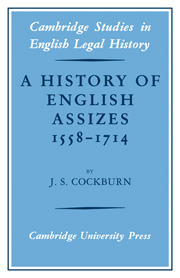Book contents
2 - The English circuits 1558–1714
Published online by Cambridge University Press: 07 October 2011
Summary
That justice may twice every year be derived to the people, in their several countries, for their great ease and benefit, the King doth in every Hilary and Trinity Term assign his justices and barons of his courts at Westminster to take assizes… in every county in his realm, except Middlesex, where his courts of record do sit, and where his courts for his county palatines be held.
The Office of the Clerk of Assize (1682), 1.The composition of the English circuits changed little in the two centuries before 1559. Middlesex was excluded from the Home Circuit and grouped, in a unique jurisdictional arrangement, with the contiguous city of London. Oxfordshire and Berkshire were transferred from the Western to the Oxford Circuit, to which Monmouthshire was also added in 1543. At the same time the Court of Great Sessions of Wales was instituted, and the Principality divided into four circuits, pleas in one of which were to be heard by the Chief Justice of Chester. After this there were no significant structural changes until the comprehensive reorganizations of the nineteenth century.
Twice yearly, normally in the Lent vacation during late February and March and the Trinity vacation during July and early August, two common law judges, a judge and a Serjeant, or, infrequently, two Serjeants literally rode each circuit, hearing pleas and delivering gaols in the county town or an important centre in every shire.
- Type
- Chapter
- Information
- A History of English Assizes 1558–1714 , pp. 23 - 48Publisher: Cambridge University PressPrint publication year: 1972



